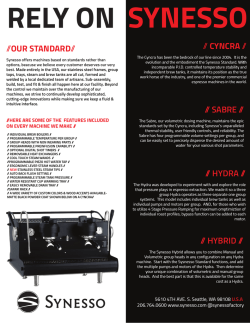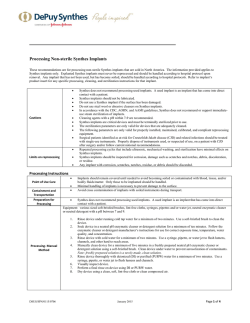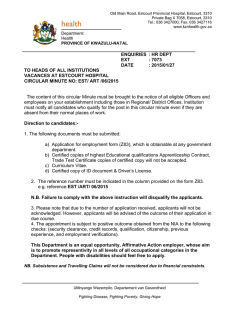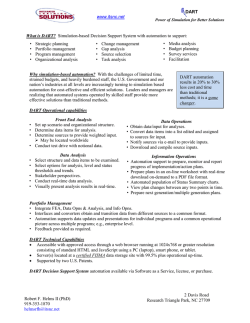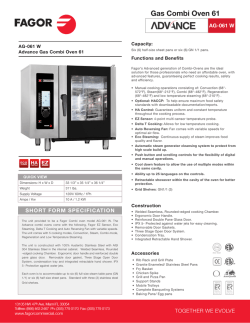
SOP 1002 Monitoring Autoclave Sterilization
STANDARD OPERATING PROCEDURES DIVISION OF COMPARATIVE MEDICINE UNIVERSITY OF SOUTH FLORIDA SOP#: 1002.8 Date Issued: 10/98 TITLE: SCOPE: RESPONSIBILITY: PURPOSE: I. Date Revised: 5/10 Page 1 of 5 Monitoring Autoclave Sterilization Animal Care Personnel Facility Manager and Technical Staff To Outline the Proper Procedures for Monitoring Autoclave Sterilization PURPOSE 1. Autoclaves are located in the All Children’s Hospital, USF Health Byrd Alzheimer’s Institute, James A. Haley Veterans Administration Hospital, College of Medicine, , Interdisciplinary Research Building, and Stabile Research Building animal facilities and used to sterilize caging, water bottles, water, feed, bedding, instruments, equipment and to decontaminate biohazardous materials. In all cases, it is important that complete sterilization is accomplished. This standard operating procedure describes the Division’s Sterilization Monitoring Program for assuring proper sterilization. II. RESPONSIBILITY 1. It is the responsibility of the Facility Manager to ensure that autoclaves are appropriately monitored and maintained in good working order. 2. It is the responsibility of the Facility Manager to ensure that all research and technical staff using autoclaves in their facility are adequately trained and experienced in these procedures. 3. The Facility Manager is responsible for maintaining records of the results of autoclave monitoring at the frequency described below, or with every load if the frequency of use is less than that described below. a. Daily- Verify® Integrator to assess steam sterilization or Steraffirm™ Steam Class 6 Emulating Chemical indicator to assess BSL-3 steam sterilization. b. Weekly- Verify® Steam Test Pack with Self Contained Biological Indicators (SCBI) to assess efficacy of steam sterilization. c. Weekly- MagnaAmp™ Biological Indicators to assess efficacy of steam sterilization of liquids. d. Daily- Air Removal Test (DART®) or Steraffirm™ Bowie-Dick Test to monitor the effectiveness of mechanical air removal from pre-vacuum steam sterilizers. 4. The Facility Manager is responsible for maintaining a log of autoclave equipment problems or failures, the corrective action taken, and how it is resolved. SOP #1002.8 Monitoring Autoclave Sterilization Effective 5/10 Page 2 of 5 5. It is the responsibility of the Facility Manager to retain autoclave records generated from the facility they manage for a period of 6 months. III. PROCEDURE 1. All Division autoclaves should be set for a temperature of 250 degrees Fahrenheit (122 degrees Celsius) for autoclaving microisolator caging. Higher temperatures can damage polycarbonate caging. 2. Steam indicators (e.g., autoclave tape, steam indicator strips) should be used in each autoclave load. These indicators change color in the presence of steam and when placed on the surface of items are a quick visible indicator that the items have been autoclaved. Steam indicators should be used on the surface of packs, containers, biohazard bags, and items to indicate the contents have been autoclaved. 3. Verify® Integrator or Steraffirm™ Steam Class 6 Emulating Chemical sterilization indicator strips can be used to assess the parameters of steam sterilization by indicating if items have been exposed to steam for an adequate time, temperature, and humidity. Place strip in a location that is considered to be the hardest for steam to penetrate. a. Surgical packs: place strip deep within the pack. b. Microisolator cages: a strip within a cage. c. Biohazardous caging: a strip within each cage. d. Miscellaneous items/loads: place a strip in center of load 4. Daily, or with each load if autoclave is not used daily, test autoclave function by placing a Verify® 810110 Integrator or Steraffirm™ Steam Class 6 Emulating Chemical PCC013 sterilization indicator strip in the deep in the center of a load. Upon completion of the cycle compare the line of indicator ink with color standard. 5. The autoclave operator should view each strip once a load is removed from the autoclave. The indicator has been adequately exposed if the ink is as dark as or darker than the color standard. If the ink is lighter than the color standard, sufficient exposure to the sterilization process may not have occurred due to equipment malfunction or a procedural error in the sterilization process. If the indicator has not fully turned color, the operation of the autoclave should be reviewed, an entry is made on the Equipment Log Sheet in the Autoclave Log Book, and the load ran again. If the strip fails to indicate adequate exposure after the second attempt, notify the Facility Manager for corrective action. 6. Sterilization monitoring strips indicate whether appropriate time, temperature, humidity are attained, but do not tell whether or not complete sterilization has occurred. To monitor whether the autoclave is completely sterilizing materials, Verify® Steam Test Packs with Verify® Self Contained Biological Indicators are used. 7. Verify® Steam Test Packs are single-use test packs designed for monitoring the effectiveness of common steam sterilizing processes, including 2500F (1210C) gravity cycles, and 2700 F (1320C) pre-vacuum cycles. This test pack SOP #1002.8 Monitoring Autoclave Sterilization Effective 5/10 Page 3 of 5 provides resistance to steam sterilization, making it suitable for use as a process challenge device that exhibits the same biological resistance as an Association for the Advancement of Medical Instrumentation (AAMI) steam test pack. 8. Weekly, or with each load if autoclave is used less than weekly, a Verify® Steam Test Pack is placed on its side, toward the front/bottom of the chamber near the drain, in accordance with SOP# 1007 Verify® Steam Test Packs/Self Contained Biological Indicators. Results are recorded in the Autoclave Sterilization Record. If after processing and incubation the contents of the vial(s) changes color (i.e., turns from blue to yellow), sterilization was not achieved. The autoclave operation should be reviewed and if working properly, times should then be increased by increments of 5 minutes and another sample should be taken. If the indicator fails to change, an entry is made on the Equipment Log Sheet in the Autoclave Log Book, and the Facility Manager is notified for corrective action. 9. Weekly, or with each load if liquids are autoclaved less than weekly, a MagnaAmp™ biological indicator is suspended within a liquid filled container (e.g., full water bottle) in an area of the load that is considered the most difficult to sterilize (e.g., within the water bottle located in the middle of the bottle rack) according to SOP# 1013 entitled Monitoring Steam Sterilization of Liquids. Results are recorded in the Autoclave Sterilization Record. If after processing and incubation the contents of the vial(s) changes color, sterilization was not achieved. The autoclave operation should be reviewed and if working properly, times should then be increased by increments of 5 minutes and another sample should be taken. If the indicator fails to change, an entry is made on the Equipment Log Sheet in the Autoclave Log Book, and the Facility Manager is notified for corrective action. 10. The DART® Daily Air Removal Tests and Steraffirm™ Bowie-Dick Test Packs are single-use test packs to assess the effectiveness of air removal from pre-vacuum steam autoclaves. The Steraffirm™ Bowie-Dick Test Packs are for use with1210-1240C (2500-2550F) pre-vacuum sterilizers. The DART® test packs are designed to be functionally equivalent to the BowieDick test described by the AAMI and are for use with 1320 to 1340C (27002740F) pre-vacuum sterilizers. a. After pre-heating the sterilizer by completing a cycle a DART® indicator is placed near the drain of an empty chamber and the DART® Test cycle (1320C/2500F for 3.5-4 minutes) is chosen from the operating menu. Upon completion of the cycle the yellow bars at the end of the indicator should turn black indicating residual air has been removed and allowing complete steam penetration. Snap off the plastic window, slide out the chemical indicator and record the results. If the indicator fails to change, an entry is made on the Equipment Log Sheet in the Autoclave Log Book, and the Facility Manager is notified for corrective action. b. After pre-heating the sterilizer by completing cycle a Steraffirm™ Bowie-Dick Test Pack is placed near the drain of an empty chamber and the Bowie-Dick Test cycle (1210 C/2500 F for 8-8.3 minutes) is chosen from the operating menu. Upon completion of the cycle the SOP #1002.8 Monitoring Autoclave Sterilization Effective 5/10 Page 4 of 5 process indicator on the outside of the pack should be darkened. After allowing test pack to cool the test pack can be opened and test sheet removed to view results. The entire indicator ink figure will change color from yellow to blue/purple if the air removal process was successful. 11. When results of autoclave monitoring are unacceptable, an entry is made on the Equipment Log Sheet stating the problem, the corrective action taken, and how it was resolved. This record is maintained in the Autoclave Log Book. 12. When autoclave equipment fails to operate properly, an entry is made on the Equipment Log Sheet stating the problem, the corrective action taken, and how it was resolved. This record is maintained in the Autoclave Log Book. 13. Most autoclave indicators have expiration dates. Autoclave operators should ensure that only in date indicators are used. 14. When autoclaves with the capability to generate printouts or temperature charts are utilized, these records of autoclave function should be reviewed from each load to assure that sterilization has occurred. The autoclave operator should make sure paper is in the printer at all times and replaced as needed. 15. Managers identify, date, and retain autoclave-generated printouts and temperature charts for a period of at least 6 months at their facility. 16. Facility Managers retain results of monitoring autoclave sterilization (i.e., records of daily DART®/ Steraffirm™ Bowie-Dick Test test, and weekly Verify® indicators) for a period of 6 months . 17. When research is being conducted in accord with 21 CFR Part 58 Good Laboratory Practice for Nonclinical Laboratory Studies and autoclave procedures/techniques could directly affect the generation, measurement, or assessment of research data, autoclave printouts are submitted to the Assistant Director for archival in accordance with 21 CFR Part 58. IV. SAFETY CONSIDERATIONS 1. Care should be taken when removing indicators from autoclaves/cages, as they can be hot. Let the indicators cool before removing. 2. Heat resistant autoclave gloves should be worn whenever removing a load from an autoclave. 3. A properly operating autoclave is essential for safety. Perceived problems should be promptly reported to the Facility Manager for assessment and corrective action to be taken. V. DOCUMENTATION REQUIRED 1. Autoclave Sterilization Record SOP #1002.8 Monitoring Autoclave Sterilization Effective 5/10 Page 5 of 5 a. Verify® Integrator or Steraffirm™ Steam Class 6 Emulating Chemical sterilization indicator strips- with each load b. Air Removal Test (DART®) Record or Steraffirm™ Bowie-Dick Test Pack –daily (when using pre-vacuum cycles) c. Verify® Biological Indicators-weekly VI. REFERENCES 1. SOP# 1007 VERIFY® Biological Indicators 2. SOPs and Operating Manuals for each facility’s autoclave. 3. Package insert directions with DART® and Steraffirm™ Bowie-Dick Test Approved: Date:
© Copyright 2025
